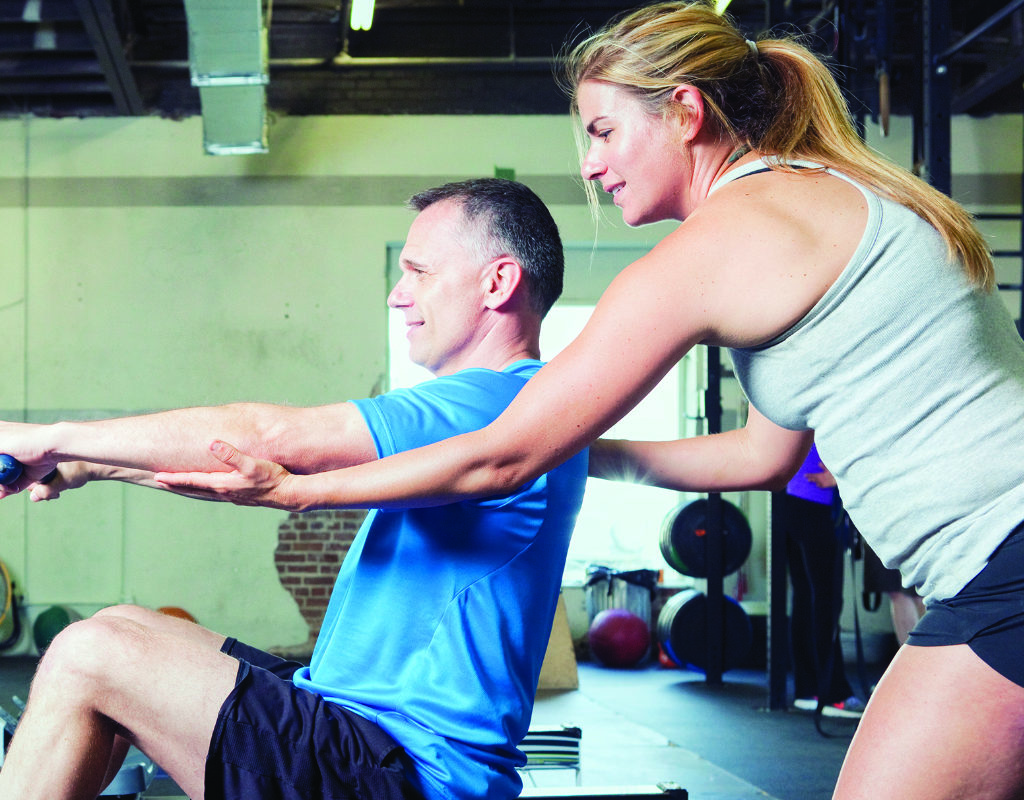Developing Your EQ: Body Language

By Judith Humphrey
I once coached a young financial executive who was tall and attractive with a warm, engaging manner. I assumed that he would come across with executive presence when he spoke to prospective investors. But, at our first coaching session I asked him to pretend he was talking to potential clients, and suddenly his body language became guarded and uninspiring.
Good body language doesn’t just happen because we are handsome or attractive. It requires an awareness of what our body is saying – and adjusting it when it sends the wrong messages. If you are a personal trainer who wants to build strong relationships with your clients—or prospective clients—you must make your body speak well for you and convey the right messages.
The following five guidelines will enable you to project body language that expresses emotional intelligence (EQ) and builds a strong relationship with your clients.
1. Create a Shared Space
Good body language requires a good setting. At the beginning of your sessions, find a spot on the floor you can share only with your client. A heavy traffic area may not be the best setting because it conveys the impression that you don’t value the one-on-one relationship with your client. And it also creates distractions.
So move away from the crowd and say, “Here’s a good spot for us” or “Let’s set up shop here.” This positioning will create a better one-on-one experience.
In creating this collaborative space you’ll also want to keep the area free from objects. Even a water bottle or a cell phone can be intrusive and create a barrier between the two of you. So create a shared space that belongs to the two of you.
2. Adopt a Strong Stance
Your stance says a lot about how focused you are on your client. If you want to show you are attentive to your client’s needs, stand tall, indicating that you are in the “ready” position and intent on helping the trainee. When your client is on the floor, you may kneel so that you are closer to her and not looking “down” on her. But, avoid slouching at all costs, for it sends a message that you are disengaged and too tired to be of assistance.
As you stand or kneel, face your client directly– don’t position yourself at an angle to her. You want to show that you are completely centered on her and ready to engage and support her.
3. Make Eye Contact
Our eyes are more powerful than all our other senses put together, so use them well.
Keep your eyes on your client. When you look intently at your client, you are saying, “I am focused on you” and “I care about everything you’re doing.” Hold eye contact when your trainee is doing specific exercises. Hold eye contact when you are praising your client or “high fiving” him. It will mean much more than praise without eye contact.
Finally, don’t let your eyes wander. A client can easily feel less important if you glance at others while you’re training. A wandering eye—even if it’s just to look at a fellow trainer—can undercut your relationship with your client by making them feel less important than the object of your gaze. So stay focused.
4. Use Open Gestures
Emotionally intelligent body language includes gestures that are open and directed to your client.
Keep your arms loose at your sides when not gesturing and avoid crossing or folding your arms—a position that suggests detachment or distance from the person you’re working with. Don’t even cross or fold your arms because you are cold. Crossed arms announce, “I’m not open to you.”
Your arm gestures should always be extended toward the client. And the best ones are full arm gestures, not gestures from the elbows or from wobbly wrists. Big gestures are powerful and convey a sense of energy and excitement about what you are saying or what you are observing.
5. The Human Touch
Touch can be a powerful expression of your emotional intelligence, but it must be handled with great sensitivity and discretion.
Touch is therapeutic. According to physicist Leonard Mlodinow, “During a conversation, a light touch can impart a subliminal sense of caring and connection, leading to more successful social interaction and even better teamwork.”
As a personal trainer, you have tremendous power to demonstrate emotional intelligence by using your hands to gently touch your client. This can be done by touching a client’s back to adjust his position when he’s doing a plank, or by holding a client’s shoulders to explain how she can perfect her posture in an exercise. If touch is as important to our health and our humanity as research says it is, these gestures are far more sensitive and effective than simply shouting, “Ribs down,” or “Pin your shoulders back.”
But, as positive and important as touching is, it must be done with professionalism. For example, a trainer should ask the client first if it’s OK to touch, before doing so. Be sure to get this permission when you begin working with a client. She will appreciate your thoughtfulness, and by asking you will make her feel less vulnerable.
Your body language speaks for you in so many ways. Use these five guidelines for projecting “body intelligence” and you will build stronger, longer lasting client relationships and a more robust business.

